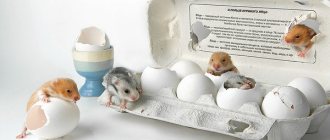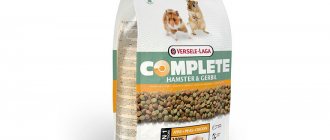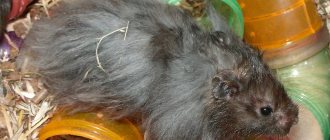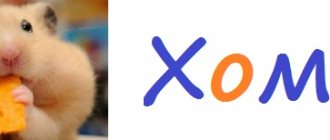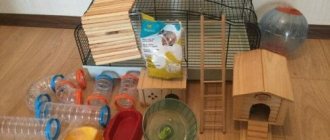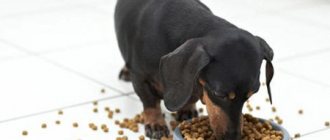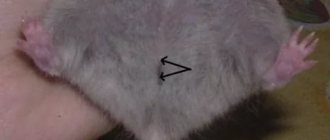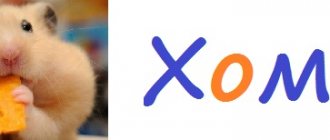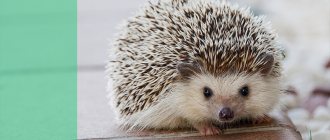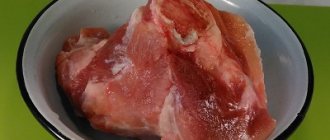Caring for a Djungarian hamster is not at all difficult. A well-equipped, comfortable cage and timely, appropriate food are the main principles of caring for a pet.
If you do not follow certain nutritional rules, the hamster may get sick and will live with the owner for a short time. Djungarians eat literally everything that is not offered.
However, not all products are recommended for them. You should include only food that is healthy for your animal in your diet. What can be given to a small animal and what cannot be given? How to create the ideal menu for a hamster? Let's consider the basic requirements for nutrition and diet.
The Djungarian hamster may not immediately evaluate the brand of the mixture; sometimes, to find the optimal option, you have to go through several brands. Usually one package of store-bought mixture lasts for one and a half or two months.
Some owners prepare grain mixtures themselves. In this case, they dilute the above composition with buckwheat, beans, lentils, and barley. It is not forbidden to add melon, pumpkin or sunflower seeds to such food.
Hamsters love nuts; you can add nuts, cashews, chickpeas, sesame seeds, and hazelnuts. Do not forget about the quality of such a mixture; all products must be fresh.
What is possible?
You can diversify your hamster's diet at home with an extensive list of products. Djungarians benefit from greens; in the summer, you can pamper your pet with clover, plantain leaves, dill, and parsley. Extensive list of vegetables and fruits.
The vegetable diet of the Djungarian hamster includes:
- Bell pepper.
- Broccoli.
- Fresh corn, beans and peas.
- Carrot.
- Cucumbers and fresh tomatoes.
- Cauliflower.
- Pumpkin.
If you include fruits in your diet, hamsters can eat bananas, grapes, apricots, apples and plums.
It is not forbidden to feed the Djungarian hamster at home with cherries, sweet cherries, rose hips, strawberries, and gooseberries. Pear should be pampered in rare cases, it “weakens”. It is worth giving hamsters protein food twice a week. Rodents eat boiled chicken meat without salt and seasonings, and peeled shrimp. You can find earthworms in pet stores. Chicken and quail eggs can be eaten in small quantities and in rare cases. The same applies to low-fat kefir.
Djungarian hamsters enjoy gnawing tree branches. Fresh branches of birch, cherry, maple, pear, oak, and apple are suitable for them.
It is important to take precautions when feeding. You need to remove seeds from fruits and berries, as jungarians can eat everything and can choke. All uneaten remains should be removed; spoiled pieces can cause poisoning.
Recommended Products
In the wild, hamsters eat mainly grain crops; this nuance can be taken into account when composing the diet of the dzhungarik.
In addition to grain crops, in the wild hamsters can also eat animal food, sometimes turning into a predator, eating carrion or killing smaller animals. At home, you should take this factor into account when choosing food.
Special dry food
Diet at home must include special grain feed.
There are a huge variety of them on our market, so you can offer the dzhungarik a choice and follow his preferences. In addition to their composition, they differ strikingly in their quality, which is also worth paying attention to. The case when a home protests and flatly refuses a certain brand is far from uncommon. Also, you should not feed your Djungarian hamster with grain mixtures intended for other animals.
Protein food
A couple of times a week you should feed the jungarik with protein foods, such as cottage cheese or a piece of boiled chicken; a boiled chicken or quail egg, or low-fat boiled fish are perfect. All of the above products must be prepared without spices and seasonings that are harmful to the small body.
Let's look at the list of products that you can still feed the homa:
| Cereals: | Nuts: | Seeds: | Greenery: |
|
|
|
|
Before feeding homa with parsley, dill and other herbs, rinse and dry it thoroughly. Thanks to this simple procedure, moisture that may contain harmful substances will disappear. Remember that parsley has a laxative effect and should not be given if the homa is pregnant.
Feed with caution
Dwarf hamsters, which include Djungarian hamsters, are prone to diabetes, so fruits and berries should be fed in moderation and carefully.
If you want to diversify your homa's diet with fresh foods, then instead of fruits, you can focus on vegetables.
Below is a list of vegetables, fruits and berries that, in moderate quantities, will not harm the health of the dwarf, but on the contrary, will replenish the supply of vitamins and nutrients.
Fruits and berries:
- Apple.
- Banana.
- Peach.
- Cherries.
- Plum.
- Blueberry.
- Rose hip.
- Strawberry.
- Grushka.
- Grape.
Fruits can be offered to Djungarian hamsters after they reach two months of age.
Make sure that no half-eaten pieces are left in the cages; they spoil quickly and can ultimately lead to poisoning of the rodent. Some varieties of pear have a laxative effect, so it should be introduced gradually and in small quantities.
Vegetables:
- Zucchini.
- Chinese cabbage.
- Eggplant.
- Cucumber.
- Radish.
- Radish.
- Cauliflower.
- Pumpkin.
- Tomato.
- Beet.
- Green beans.
- Fresh corn.
- Carrot.
Tomatoes can be fed to homa if they are grown in your garden, since the varieties sold on the market often contain a lot of pesticides.
A similar rule is fully applicable to cucumbers. Beets will not harm your pet, but they actually do not contain any beneficial substances. But carrots must be included in the homa diet.
Dried fruits:
- Banana chips.
- Dried apples.
- Dried pears.
- Dried apricots.
- Raisin.
Fruits and vegetables grown yourself or purchased from safe places will be a big plus.
Poisoning people with pesticides is far from uncommon, let alone such miniature creatures, for which such a dose would be fatal. As for dried fruits, due to their high sugar content, they should be given in small quantities.
Do not allow dzhungarik to eat citrus fruits, they are harmful for such a small organism, this rule also applies to sour berries, such as barberry or sea buckthorn. Tropical fruits should be avoided in the homa diet, with the exception of bananas or banana chips.
What fruits should you not give your hamster?
It is worth considering that not all fruits are equally beneficial for hamsters. Among the variety of fruits, there are many that are not recommended for rodents. If you feed a hamster a forbidden fruit, it can not only harm him, but also lead to his death.
Dangerous fruits for hamsters:
- Mango;
- Avocado;
- Persimmon;
- Kiwi;
- A pineapple;
- Lemons;
- Tangerines;
- Oranges;
- Coconut;
- Figs;
- Feijoa.
In nature, hamsters do not eat exotic fruits, so the gastrointestinal tract of rodents is not able to digest them. Citrus fruits contain large amounts of vitamin C, which can lead to hypervitaminosis. Citrus fruits also contain a large amount of organic acids that irritate the gastrointestinal tract.
List of prohibited products
You should not give white cabbage to dzungarians to eat, it causes increased gas formation and is difficult to digest. There have been cases when it caused the death of a poor rodent. Limit khoma from potatoes, they are too hard to digest and can contain huge amounts of pesticides, plus they have too much starch.
Remember that any branches of fruit trees collected in the city can seriously harm the dzhungarika, having a detrimental effect on health. Given our ecology, this fact does not even require explanation.
Good quality twigs can be purchased at pet stores, but be sure to heat them before giving them to your rodent.
Under no circumstances give Djungarian hamsters food from your table.
Fried, fatty and floury foods are very harmful to his health. Below, in the list, we will take a closer look at the foods that should not be given to Djungarian hamsters, these are:
- Salt.
- Pepper.
- Sugar.
- Honey.
- Onion.
- Watermelon.
- Sour cream.
- Chocolate.
- Kiwi.
- Pomegranate.
- Mint.
- Sorrel.
- Cherry or apricot pits.
- Coniferous tree branches.
- Sausage.
- Bread.
- Cookie.
- Pasta.
- Garlic.
- Almond.
- Milk.
- Cheese.
There is a lot of debate about foods that should or should not be included in a hamster's diet, with one half arguing for harmlessness or healthfulness, and the other taking the opposite point of view. These products include beets, radishes and bananas.
In any case, the choice will be yours; if you have concerns about giving this or that food, it is better to refuse than to reproach yourself for what you have done. After all, the list of products that are completely harmless for Djungarian hamsters is quite extensive.
Citrus fruits (oranges, tangerines and lemons)
Absolutely any citrus fruits (tangerine, lemon, lime, orange, grapefruit, pomelo) cannot be given to hamsters. These fruits are harmful for the following reasons:
- a high content of vitamin C can provoke hypervitaminosis;
- acids from citrus fruits corrode tooth enamel and irritate the mucous membranes of the esophagus, stomach and intestines;
- cause allergies.
It must be remembered that both the pulp of citrus fruits and their peel are harmful. Even intensive washing is not able to wash away the chemicals used for preservation from imported fruits.
We create the “correct” diet for the Djungarian hamster
The food that is suitable for feeding the dwarf at home is practically no different from the food that it obtains in its natural environment, that is, in the wild.
Cereals, nuts
So, the most common food for Djungra hamsters are cereals, namely:
- buckwheat;
- Hercules;
- wheat;
- barley;
- legumes (peas, beans, beans, lentils).
You can even prepare food for your Djungarian hamster at home by mixing all of the above products in equal proportions.
Sunflower, melon or pumpkin seeds are often used as an additive. But if for some reason you do not have the opportunity or time to prepare food for your pet, then you can purchase a ready-made cereal mixture at any specialized store.
Such domestic rodents as dzhungariki do not refuse nuts, which, by the way, are very beneficial for the body of fluffies. Therefore, experienced zoologists strongly recommend introducing nuts such as cashews, hazelnuts, chickpeas, walnuts, and even sesame seeds into the daily diet of hamsters.
Greenery
Now let's talk about fresh greens, without which hamsters cannot fully develop. Of course, in late autumn, winter and early spring it is extremely difficult to enrich the diet of a furry friend with such food (if you do not grow greens at home), but what prevents us from introducing greens into the pet’s menu at other times of the year?
Clover, nettle, plantain, dandelion, parsley, lettuce, dill - Djungarian hamsters eat all this with great pleasure.
Vegetables fruits
Fortunately, hamsters are accustomed to eating almost all vegetables and fruits. But so that you have no doubts about whether to give this or that product to your pet, let's take a closer look at all the vegetables and fruits that should be in the diet of a dzhungarik.
For convenience, we have combined all the data into a single table.
| Vegetables | Fruits | Berries |
| Sweet peppers (bell peppers), beets, carrots, eggplants, zucchini, squash, pumpkin, cauliflower, Chinese cabbage, broccoli, green peas (young), corn, cucumbers, seasonal tomatoes (not greenhouse), radishes, radishes, celery roots and greens , beans in pods. | Apricot, banana, pear, peach, apple. | Cherry, strawberry, plum, currant, grape, blueberry, gooseberry, sweet cherry, rose hip. |
During the cold season, it is extremely difficult to provide your pet with a nutritious diet. But if you worry about this in advance, then in summer or autumn you can stock up on dried fruits or frozen foods (vegetables, fruits, berries).
It has been clinically proven that a balanced diet, which contains all of the above products, ensures the full growth and development of the rodent, and also strengthens its immune system.
Treats
Hamsters are very fond of bamboo shoots, sprouted oats, wheat and alfalfa.
Therefore, if you want to pamper your pets, then this treat is perfect for this role. In the warm season, dzhungarikas can be offered branches of deciduous and fruit trees. Believe me, almost all hamsters love to chew such a treat.
Birch, beech, cherry, maple, pear, oak, apple, poplar twigs will not only clean your furry pet’s teeth, but will also saturate his body with all useful substances.
Protein products
In order for your fluffy to fully develop, his diet must contain protein food, which is ideal for boiled chicken meat (without seasonings and salt), shrimp meat, and earthworms.
As for the latter, qualified specialists strongly recommend purchasing this type of protein food exclusively in zoological stores, because worms dug up in the front garden may contain harmful substances that will negatively affect the health of the hamster.
Eggs can also be a good source of protein. The Djungarik menu may include both quail and chicken eggs, but giving them more than twice a week is extremely undesirable. Fermented milk products (kefir and homemade yogurt) in your furry pet’s menu should be low-fat, maximum 1%, otherwise the hamster will have digestive problems, which can be eliminated with rice water.
As for the nutrition of babies who do not have enough mother's milk, dairy-free cereals, baby food and lean baby purees without any additives are suitable as complementary foods.
Rules for feeding at home
In the wild, the daily menu of hamsters is determined by their habitat. To ensure that your pet does not experience a shortage of essential food in captivity, you need to carefully think through the diet and maintain a balanced level of macro- and microelements in the animal’s body.
Mode
Veterinarians recommend feeding your hamster 2 times a day - morning and evening. It is better to give fresh food first so that the rodent does not start hiding it in the pantry. The bulk of the food is served in the evening. Hamsters are crepuscular rodents that prefer a nocturnal lifestyle.
To prevent your pet from overeating or experiencing food shortages, you need to adhere to the established feeding regimen.
Quantity
Depending on the age and size of the pet, different amounts of food are required. The hamster consumes quite a lot of food, and the daily norm is 80-100% of body weight. Appetite is determined by breed characteristics, microclimate and individual preferences of the individual.
The hamster considers food not only as part of the daily menu, but also as a strategic reserve. Therefore, uneaten food is put aside by the rodent in case of starvation. This leads to the appearance of an unpleasant odor and the development of pathogenic organisms in spoiled products. To prevent such troubles, you should remove the remains in a timely manner. Instead, you can put a few seeds in your pet's storage.
Catering
A new product should be introduced into the diet of a Djungarian hamster in small pieces, and the reaction and condition should be observed. Gradually the volume is increased.
So, the pet’s menu should include basic food, the food should be enriched with fruits, vegetables, and herbs from the list of recommended products.
Hamsters eat frequently, and they also store food. Spoiled food should be removed from the house to avoid rotting and mold. In addition to spreading unsanitary conditions, the hamster can become poisoned.
Organizing meals at home is not difficult. In order for your hamster to feel good, it is important to avoid prohibited foods, not feed it human food, and keep the cage clean. Only in this case will the dzhungarik feel good, please the owner with funny behavior and live the time allotted to him.
Encouragement during training
A nice bonus will be the opportunity to teach the animal tricks. Do you want your pet to become tame and not be afraid of people? A handful of dried fruits and patience can serve as helpers in this difficult task. It is enough to follow simple steps and you will definitely achieve results. Reaching out your hand to the animal or just into the cage, hold pieces of food (fruits, grains, nuts). It's better to choose what he likes best. Over time, he will get used to your hand, it will be associated with pleasant sensations: sweet taste, satiety, pleasure. At first, place the gift away from the hamster and take your hand. Then try leaving the treat on your palm - the rodent will climb up and eat the treat right there. Start to slowly pull the baby out of the cage, the main thing is not to scare him away. They say that with the help of treats you can teach some other tricks, such as responding to a name, the command “fu!”, turning over on its back, sitting quietly on your shoulder, searching for a treat in a maze, etc. Avoid overtiring the rodent, otherwise he will quickly lose interest to learning.
